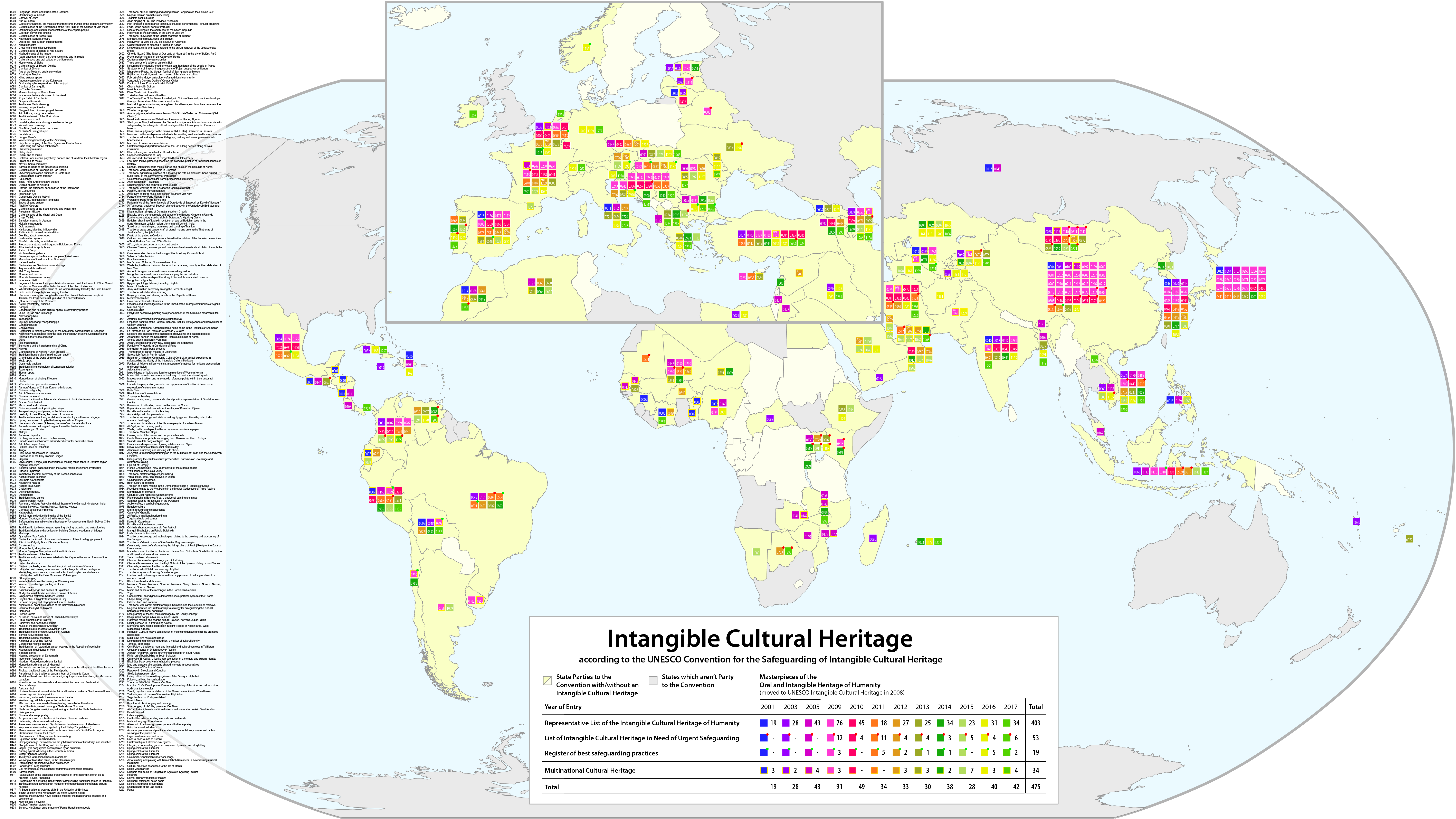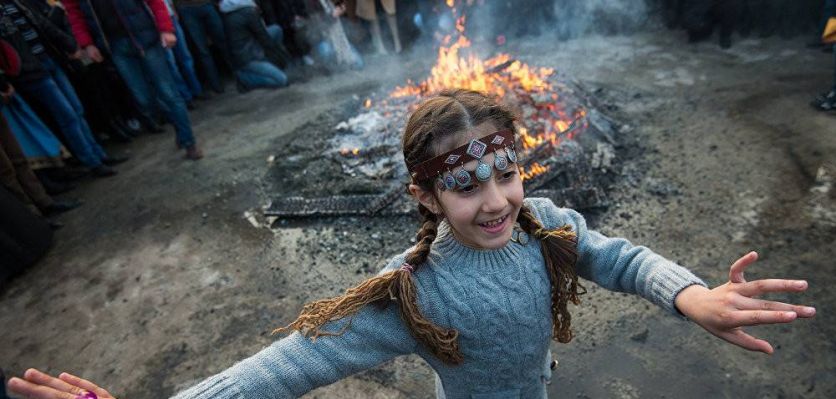Trndez/Tiarnundaraj: 9 things you didn't know about the age-old Armenian tradition
February 12, 2019
Have you ever witnessed the age-old Armenian tradition of jumping over a ceremonial bonfire in February? Perhaps you’ve participated the longstanding custom, but never understood the story behind it. The ritual has many names: Trndez, Tiarnundaraj, Derendez—but whatever you call it, it’s definitely one of the most fascinating—and potentially dangerous—Armenian traditions, still carried on today.
1. The tradition traces its roots to the pagan times

The celebration is rooted in Armenian pagan tradition. Originally called “Derendez,” which meant “a bundle of hay in front of your house,” it was intended as a wish of prosperity to the home and fertility to the land. In ancient Armenia, the holiday was associated with the worship of Vahagn—the god fire, the sun, and of war and courage, and the Armenian counterpart of the Zoroastrian god of victory Verethragna. (Illustration: Jumping over the Trndez flames. beegfree.org)
2. It’s all about the fire

The purifying qualities of fire were at the center of pre-Christian Armenian tradition. According to several sources, people believed that the strength of the fire would eradicate the winter’s cold and allow for fertile land and a prosperous harvest. Couples—especially newlyweds—would jump over the Trndez flames for luck, prosperity, and fertility. Even the fire’s ashes were believed to have healing properties as people would use it as an ointment for pain and rub it into their eyelids to improve their eyesight! Ouch! (Photo: Jumping over the Trndez flames. Brian Saliba/Flickr)
3. Incorporation by the Church

Following the Christianization of Armenia, the Armenian Church decided to adapt the festival rather than to suppress and do away with it completely. In the tradition of the Church, the celebration is officially named “Tiarnundaraj” (“coming to meet the Lord” or Candlemas as it is known in the West), and symbolizes the presentation of the 40-day-old Christ Child to the Temple in Jerusalem. (Photo: His Holiness Catholicos Aram I lights the Tiarnundaraj flame in Antelias, Lebanon, in 2017. Aztag)
Incorporation by the Church (cont.)

Evening Services or “Nakhatonak” are conducted on the eve of the Feast Day, after which a priest lights a candle from the Holy Altar, begins a bonfire, and distributes the flame to parishioners. Check out this beautifully shot video of a Tiarnundaraj celebration in Armenia in 2019. (Photo: The Tiarnundaraj bonfire lit in front of the St. Grigor the Illuminator Church in Yerevan. Sputnik)
4. Feb. 13 or 14?

Every time February rolls around, there seems to be some confusion about the date on which Trndez is celebrated. According to the Armenian Apostolic Church, the celebration is a four-day Feast, which is celebrated 40 days after Jesus' birth. Since the Church celebrates Christmas on Jan. 6, that means Tiarnundaraj is always officially observed on Feb. 14. The confusion may be attributed to the fact that the bonfire begins to burn on the evening of the 13th. According to church order, the day changes after Evening Services. That is to say, the Trndez flames burn on the 14th according to the church calendar, although it is still Feb. 13 in the secular calendar! (Photo: A scene from a traditional Trndez celebration in Yerevan in 2018. Sputnik)
5. Similar celebrations across the globe

Certain elements of Trndez—especially the practice of jumping over flames—are carried on in different cultures and traditions throughout the world. Chaharshanbe Suri, an ancient Iranian festival celebrated on the eve of the last Wednesday before Nowruz (Persian New Year), features participants jumping over a bonfire in a purification ritual. (Photo: A scene from a Chaharshanbe Suri celebration. mehrnews.com)
Similar celebrations across the globe (cont.)

Similarity, Hıdırellez, celebrated throughout the Turkic world on May 5-6, is a tradition to ring in the arrival of spring and considered an Alevi religious holiday. Some other examples include Kupala Night, which is celebrated in Ukraine, Poland, Belarus, and Russia, and Jaanipäev, which is observed in Estonia. (Photo: A photo of two well-known Persian songstresses, Hayedeh and Mahasti, leaping over the Chaharshanbe Suri fire, dons the cover of a popular Iranian magazine in March, 1975. PD- Iran)
6. Trndez is nominated for UNESCO’s List of Intangible Cultural Heritage

Trndez was officially nominated for UNESCO’s List of Intangible Cultural Heritage (ICH) of Humanity in 2016 and is on the organization’s tentative IHC list. Armenia is represented on the Representative List of ICH of Humanity by the following elements: Duduk and Its Music (2008); Armenian Cross-Stones Art; Symbolism and Craftsmanship of Khachkars (2010); Performance of the Armenian Epic of “Daredevils of Sassoun” (2012); Lavash, the Preparation, Meaning and Appearance of Traditional Bread as an Expression of Culture in Armenia (2014); and Armenian letter art and its cultural expressions (2019). (Map: Distribution, by country, of UNESCO’s Intangible Cultural Heritage (ICH) of Humanity. UNESCO)
7. The tradition is memorialized on an Armenian stamp

Trndez is a big deal in Armenia—such a big deal, in fact, that HayPost, the country’s official national postal operator, issued commemorative postage stamps back in 1998, dedicated to the centuries-old tradition. The stamp features a newlywed couple hurdling over the Trndez flame, while a band plays traditional Armenian musical instruments, including the Zurna (wind instrument) and the Dhol (double-headed drum) in front of an ancient Armenian cathedral. (Photo: Commemorative Trndez stamps, issued in Armenia in 2008. StampCircuit)
8. Accidents happen…

In his 1926 book When I was a Boy in Armenia, Manoog Der Alexanian recounts his experiences celebrating the longstanding Armenian custom of Trndez, which he describes as a day the Armenian people build bonfires and dance around them. “Many young men consider it great fun and a clever thing to jump over the bonfire,” Der Alexanian writes in his memoir, “but through such daring, there have been those who have fallen into the fire and been badly burned.” Next time February rolls around, don’t forget to be extra careful while joining in on the traditional fun! Check out Harvard-grad Manoog Der Alexanian’s 1926 book in its entirety here. It is a sincere look into a life in the old country and a delightful book for all ages to learn the history, lifestyle, and cultural practices of Western Armenia, seen through the eyes of a young boy. (Photo: The cover of When I was a Boy in Armenia; worthpoint.com)
9. Let’s not forget the food!

OK… So Trndez isn’t only about the fire, after all. Traditionally, during the celebration, Armenians prepared—and indulged in—a tasty treat called aghandz. A concoction of roasted wheat and hemp, aghandz was enjoyed by the newly married or engaged couple after clearing the flames of the Trndez bonfire. Often times sesame seeds, peas, raisins, and other dried fruits were added to the aghandz mix. making a sweet dessert mixture. Abundant trays full of delicious delicacy, along with a similar treat called pokhind (baked and milled grain kneaded with honey or fruit syrup), were typically brought for all to share around the fire. For a traditional aghandz recipe, check out this video. (Photo: Aghandz is an Armenian dish, traditionally served during Trndez. Armen Yeritsyan)
What's your favorite Armenian tradition? Let us know in the comment section below!
References
- Alexanian, Manoog der. When I Was a Boy in Armenia. Lothrop, Lee & Shepard Co., 1926.
- “Celebrating with the Natural World This Holy Day Season.” Bodhi Tree, 9 Aug. 2018.
- “Culture of Iran: Festival of Fire.” Historic Personalities of Iran: Mohammad Reza Shah Pahlavi.
- “Intangible Cultural Heritage.” Intangible Cultural Heritage Website, UNESCO,
- Noble, J. Lonely Planet Georgia Armenia & Azerbaijan. Lonely Planet, 2012.
- Petrosian, Irina, and David Underwood. Armenian Food: Fact, Fiction & Folklore. Yerkir Publishing, 2006.
- “Terndez: a Holiday for Newlyweds.” Armedia.am.
- “Trndez: Christian Armenians Celebrate Feast of Purification - Arts and Culture.” ArmeniaNow.com.
Video
Join our community and receive regular updates!
Join now!



Attention!